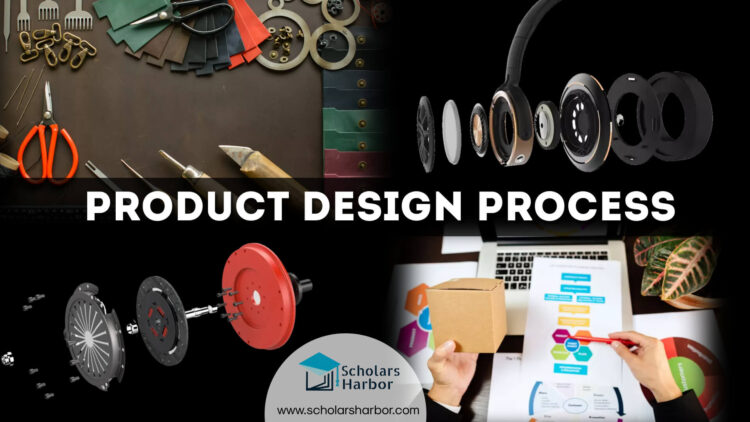A product is the ultimate outcome of ideas and design evolution procedures. Product development can occur through inventions, which are items created from unique concepts and ideas, or through innovations, which are improvements to existing products.
Product Design:
The process of specifying all of the company’s product attributes is defined as product design. Product design must assist product manufacturability, which refers to how easily a product may be manufactured.
Product design specifies the following characteristics of a product:
- Visual appearance
- Materials
- Measurements
- Tolerances
- Performance indicators
Product Design is a series of actions for the development of new solutions that include innovative ideas for innovation, creative solutions to difficulties, and effective judgement over technology, marketplace, and time.
Factors Influencing Product Design:
- Need/Function – The desire to fulfil a certain need/purpose. For example, what will the product be used for?
- Consider client preferences – taste, likes, and dislikes – while producing a product. A market survey might be undertaken to determine customer preferences.
- Materials – The availability of new materials and their development have an impact on design outcomes. Some materials are best suited to a specific function. Material research should play a significant role in product creation and development.
- Price – the cost of materials & labor may have an impact on product creation. Is the product reasonably priced? If the cost is prohibitively exorbitant, its market viability may suffer.
- Ergonomics – Human-designed items must have dimensions and sizes that make them easy to use. As a result, while producing products, sizes and end-user comfort must be taken into account.
- Fashion – The design style of a product determines how people react to it in terms of demand. What is recent and contemporary in fashion influences people’s fashion habits. Fashion trends often influence product design.
- Aesthetics – The core of a product’s beauty/style is the way shape/form and colors are integrated. Aesthetics influences how a thing is manufactured and looks.
- Culture determines how a product is seen, whether it is acceptable or not. The usage of pattern, colors, production process, and so on may have a significant impact on how individuals from various cultures perceive a product.
- Production methodology – the production approach can affect how the final product appears. There are several methods for producing a product, ranging from handcrafted to machine-made.
- Company identity – Companies that manufacture products always want to maintain their own identity, which can take the shape of a logo, a slogan, or other means. To distinguish their items, they may favour distinct colors or design patterns.
- Environment – Environmental issues are increasingly influencing how consumers think about the products they buy. People are thinking about the environmental effect of their products, whether they are made from renewable or nonrenewable resources, and how they are made. Using eco friendly items is popular. This encourages the usage of reclaimed materials.
- Human capital consists of knowledge and skills gained through human growth. The application of scientific and technological understanding to enhance material quality and manufacturing processes.
- Workplace safety entails implementing safety requirements during the material procurement and manufacturing operations. This is frequently backed up by legislation – laws.
- Time – The lead time in design and manufacturing should be as short as possible. Time is of the essential not just for bringing a product to market, but also for capitalizing on market possibilities.
Product Development Process
- New product concept
- Marketing initiatives
- Technical engineering design
- Production plan development
- Product design validation
- Distribution strategy
Product Development vs Product Design
Product development comprises the entire range of tasks necessary to bring a fresh concept to market readiness. The product design process, on the other hand, is a collection of technical operations inside a Product Development Cycle that seek to satisfy the business and marketing strategy objectives. This set includes new product concept development and implementation technology.
Types of Design and Redesign
- Original-Product Design
- Adaptive-Product Design
- Variant-Product Design
Step 1 – Idea Generation
Someone identifies a need and creates a product or service to fulfill it: Variables to take into account include consumers, branding, technology, competitors, benchmarking, and reverse engineering.
Step 2 – Product-Review
Every organization needs a rigorous, organized evaluation procedure that takes into account and the factors including facility compatibility, labor skills, market size, net profit, break-even analysis, and ROI.
Step 3 – First Design and testing phase
Prototypes are built, engineering requirements are developed, and testing is undertaken.
Step 4 – Final Design
Test results were used to determine the final design, the facility, the equipment, the materials, the labor skills, and the suppliers.
Types of Design with Examples:
| Original | Adaptive | Variant | |
| Brakes | Antilock Brakes | Brake system for a new vehicle | System resized for a slightly modified vehicle, a different disc diameter, or a different friction material |
| Steering | Assistive technology for people with disabilities | New column including secondary functions | steering column resized to fit a resized chassis |
| Entertainment | CD media | DVD media | Laser disc storage medium |
| Computing | Microprocessor | Intel 8080 chip | Chip refinement from Pentium to Pentium 2 |
| Vehicles | Benz’s first automobile | Unibody construction (vs. body on frame) | Any newer year model in comparison to a previous year |
| Bearings | Da Vinci’s self centering Ball Bearing | First Teflon-coated plain bearings | Size variations in a family of similar bearings |
Cite this Article
| Author: | Scholars Harbor |
| Year: | 2022 |
| Title | Product Design Steps | Types & Examples of Product Design |
| Publisher: | Scholars Harbor |
| URL: | https://scholarsharbor.com/product-design-steps-types-examples-of-product-design/ |












Discussion about this post